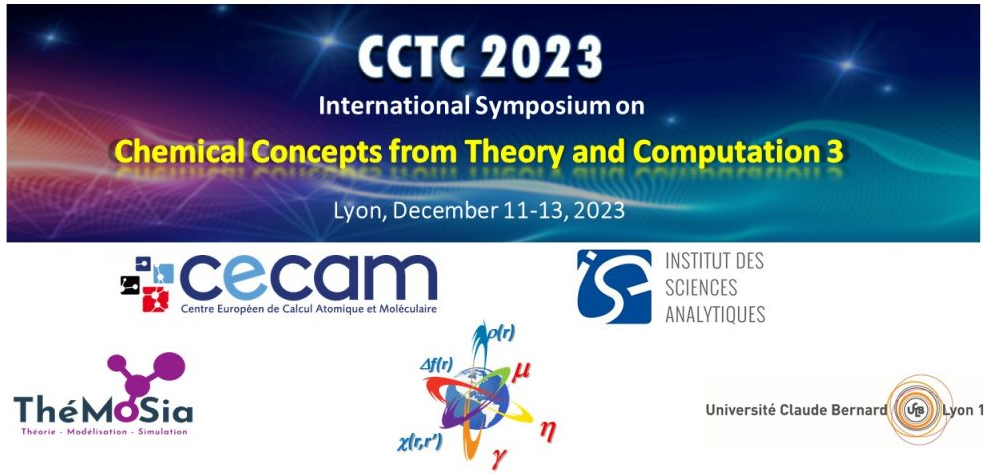Congrès CCTC3 (11-13 Décembre)

The CECAM workshop will take place at the amphitheater of CNRS (Organizer : Pr. Christophe Morell (contact : christophe.morell@univ-lyon1.fr ).
https://www.cecam.org/workshop-details/1219
For more information (List of Participants, Program) : https://cctc3.sciencesconf.org/
Chemical “in silico” simulations are nowadays close to replace chemical experiments. Yet as the calculations become both more sophisticated and accurate, the gap between the simulation outputs and their chemical interpretation1 grows larger and larger. The understanding of chemical concepts from the viewpoint of theory and computation is a persistent challenge. Three quantum machineries are currently still in use in theoretical chemistry, namely by chronologic order Valence Bond theory2 (VB), Molecular Orbital Theory3(MOT) and Density Functional Theory4 (DFT). Every one of them have stemmed a bunch of concepts and descriptors enabling the rationalization of the calculations results in Layman’s terms.
In molecular orbital theory, it is well known that the chemical conceptualization lagged behind computational methodology development. The scattering of the electron wave across the molecular system is certainly at the origin of this lag. Still, Frontier Molecular Orbital Theory5 (FMOT) and the conservation of the orbital symmetry6 are two conceptual tools that have become handy for predicting the outcome of a chemical process. They are the most taught concepts worldwide even though orbital are not quantum observables. By contrast, in valence bond theory (VBT), where the advantage of chemical intuition is apparent and that has been prolific in terms on interpretative theories, VB programs are still limited to small molecules. Indeed, most of the concepts used by experimentalists, such as the free valence index7 or the resonance hybrids, come from valence bond theory. Density functional theory (DFT) is accepted as the most prevalent computational method developed in past decades. However, most people are unfamiliar that DFT also provides a conceptual framework. Conceptual DFT8,9,10 (CDFT) provides robust mathematical and physical grounds for conventional chemical concepts like electronegativity11, hardness12, electrophilicity13, and many other14–17, but is still somewhat controversial. Similarly, Quantum Chemical Topology (QCT) descriptor1 are gaining popularity in the theory of chemical bonding. Sharing the same basic ingredient (i.e. the electron density and its derivatives), these approaches divide the real-space into chemically meaningful regions such as atoms (QTAIM18), cores, bonds or lone-pairs (ELF19) or highlight non-covalent interactions (Non Covalent Index or NCI20).
The purpose of this symposium is to foster discussions between experts from the DFT, MOT and VBT and QTAIM communities on stability, bonding, reactivity, non linear optics, molecular electronics, among others. We will also welcome experts in the emerging field of artificial intelligence applied to theoretical chemistry21. We especially encourage contributions that provide a broader perspective on conceptual quantum chemistry and/or establish common ground between different theoretical/computational approaches. Our ultimate aim is to provide chemical meaning to high-level quantum computations thus filling the ever-growing gap between experimentalist and computational chemists.
References.
1. Head-Gordon, M. Quantum chemistry and molecular processes. J. Phys. Chem. 100, 13213–13225 (1996).
2. Pauling, L. The Nature of the Chemical Bond. J. Am. Chem. Soc. 53, 1367–1400 (1931).
3. Mulliken, R. S. Spectroscopy , Molecular Orbitals , and Chemical Bonding. Science (80-. ). 157, 13–24 (1967).
4. Hohenberg, P. & Kohn, W. Inhomogeneous Electron Gas. Phys. Rev. 136, B864 (1964).
5. Fukui, K., Yonezawa, T. & Phys, S. H. J. C. Perspective Perspective on « A molecular orbital theory of reactivity in aromatic hydrocarbons ’ ’. 219–220 (2000) doi:10.1007/s002149900031.
6. Hoffmann, R. Interaction of Orbitals through Space and through Bonds. Acc. Chem. Res. 4, 1–9 (1971).
7. Moffitt, W. The residual affinity of conjugated and resonating hydrocarbons. Trans. Faraday Soc. 45, 373–385 (1949).
8. Chermette, H. Chemical reactivity indexes in density functional theory. J. Comput. Chem. 20, (1999).
9. Geerlings, P., De Proft, F. & Langenaeker, W. Conceptual density functional theory. Chem. Rev. 103, 1793–873 (2003).
10. Geerlings, P. et al. Conceptual density functional theory: status, prospects, issues. Theor. Chem. Acc. 139, (2020).
11. Parr, R. G., Donnelly, R. A., Levy, M. & Palke, W. E. Electronegativity: The density functional viewpoint. J. Chem. Phys. 68, 3801–3807 (1978).
12. Parr, R. G. & Pearson, R. G. Absolute hardness: companion parameter to absolute electronegativity. J. Am. Chem. Soc. 105, 7512–7516 (1983).
13. Parr, R. G., von Szentpaly, L. & Liu, S. Electrophilicity index. J. Am. Chem. Soc. 121, 1922–1924 (1999).
14. Morell, C., Grand, A. & Toro-Labbé, A. New dual descriptor for chemical reactivity. J. Phys. Chem. A 109, 205–212 (2005).
15. Geerlings, P. & De Proft, F. Conceptual DFT: the chemical relevance of higher response functions. Phys. Chem. Chem. Phys. 10, 3028–42 (2008).
16. Boisdenghien, Z., Fias, S., Van Alsenoy, C., De Proft, F. & Geerlings, P. Evaluating and interpreting the chemical relevance of the linear response kernel for atoms II: open shell. Phys. Chem. Chem. Phys. 16, 14614–24 (2014).
17. Sowlati-Hashjin, S. et al. Manipulation of Diatomic Molecules with Oriented External Electric Fields: Linear Correlations in Atomic Properties Lead to Nonlinear Molecular Responses. J. Phys. Chem. A 124, 4720–4731 (2020).
18. Bader, R. F. W. Atoms in molecules. Acc. Chem. Res. 18, 9–15 (1985).
19. Savin, A. On the significance of ELF basins. 117, 473–475 (2005).
20. Johnson, E. R. et al. Revealing noncovalent interactions. J. Am. Chem. Soc. 132, 6498–6506 (2010).
21. Miranda-Quintana, R. A., Kim, T. D., Heidar-Zadeh, F. & Ayers, P. W. On the impossibility of unambiguously selecting the best model for fitting data. J. Math. Chem. 57, 1755–1769 (2019).
22. Popelier, P. L. A. Quantum chemical topology: On bonds and potentials. Struct. bonging (2005) doi:doi.org/10.1007/b135617.
